《金融机构体系》习题及答案
李健《金融学》课后习题及详解(金融机构体系)【圣才出品】
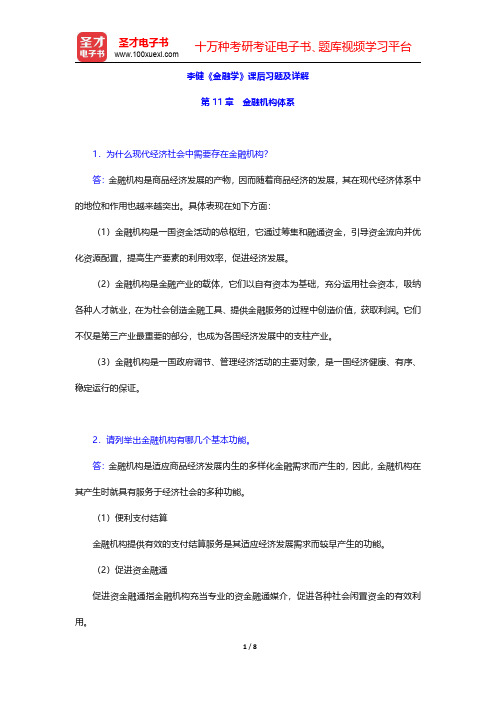
李健《金融学》课后习题及详解第11章金融机构体系1.为什么现代经济社会中需要存在金融机构?答:金融机构是商品经济发展的产物,因而随着商品经济的发展,其在现代经济体系中的地位和作用也越来越突出。
具体表现在如下方面:(1)金融机构是一国资金活动的总枢纽,它通过筹集和融通资金,引导资金流向并优化资源配置,提高生产要素的利用效率,促进经济发展。
(2)金融机构是金融产业的载体,它们以自有资本为基础,充分运用社会资本,吸纳各种人才就业,在为社会创造金融工具、提供金融服务的过程中创造价值,获取利润。
它们不仅是第三产业最重要的部分,也成为各国经济发展中的支柱产业。
(3)金融机构是一国政府调节、管理经济活动的主要对象,是一国经济健康、有序、稳定运行的保证。
2.请列举出金融机构有哪几个基本功能。
答:金融机构是适应商品经济发展内生的多样化金融需求而产生的,因此,金融机构在其产生时就具有服务于经济社会的多种功能。
(1)便利支付结算金融机构提供有效的支付结算服务是其适应经济发展需求而较早产生的功能。
(2)促进资金融通促进资金融通指金融机构充当专业的资金融通媒介,促进各种社会闲置资金的有效利用。
(3)降低交易成本降低交易成本是指金融机构通过规模经营和专业化运作,适度竞争,可以合理控制利率、费用、时间等成本,取得规模经济和范围经济的效果,并使得投融资活动最终以适应社会经济发展需要的交易成本来进行,从而满足迅速增长的投融资需求。
(4)改善信息不对称由于金融机构利用自身的优势能够及时搜集、获取比较真实、完整的信息,通过专业分析判断,据此选择合适的借款人和投资项目,对所投资的项目进行专业化的监控。
(5)转移与管理风险转移与管理风险是指金融机构通过各种业务、技术和管理,分散、转移、控制或减轻金融、经济和社会活动中的各种风险。
(6)创造信用与存款货币金融机构在其业务活动中可以创造各种信用工具,中央银行的资产业务可以直接授信给金融机构,负债业务可以直接发行信用货币。
金融学练习题库(附参考答案)
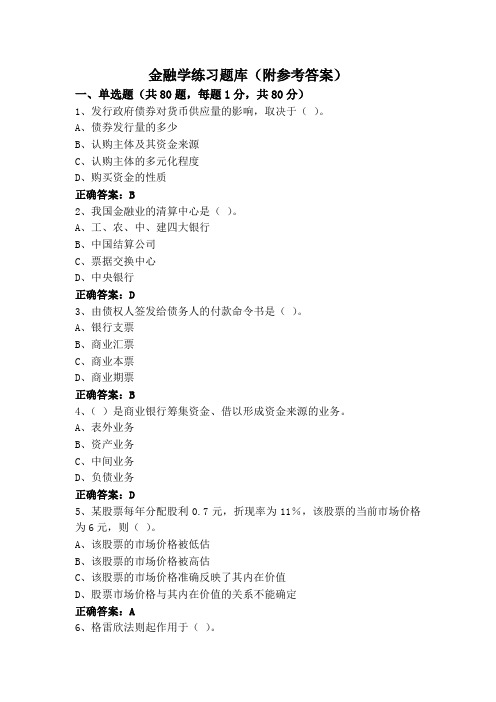
金融学练习题库(附参考答案)一、单选题(共80题,每题1分,共80分)1、发行政府债券对货币供应量的影响,取决于()。
A、债券发行量的多少B、认购主体及其资金来源C、认购主体的多元化程度D、购买资金的性质正确答案:B2、我国金融业的清算中心是()。
A、工、农、中、建四大银行B、中国结算公司C、票据交换中心D、中央银行正确答案:D3、由债权人签发给债务人的付款命令书是()。
A、银行支票B、商业汇票C、商业本票D、商业期票正确答案:B4、()是商业银行筹集资金、借以形成资金来源的业务。
A、表外业务B、资产业务C、中间业务D、负债业务正确答案:D5、某股票每年分配股利0.7元,折现率为11%,该股票的当前市场价格为6元,则()。
A、该股票的市场价格被低估B、该股票的市场价格被高估C、该股票的市场价格准确反映了其内在价值D、股票市场价格与其内在价值的关系不能确定正确答案:A6、格雷欣法则起作用于()。
A、跛行本位制B、平行本位制C、单本位制D、双本位制正确答案:D7、根据我国《商业银行法》规定,在改革开放后逐步建立起来的我国现行的商业银行体系,目前采用的是()模式。
A、职能分工B、混业经营C、单元型D、全能型正确答案:A8、人民币从中国人民银行现金发行库直接进入商业银行和其他金融机构现金业务库的过程,称为()。
A、现金发行B、现金投放C、现金归还D、现金回笼正确答案:A9、直接金融市场和间接金融市场的区别在于()。
A、是否存款中介机构B、中介机构在交易中的地位和性质C、是否存款固定的交易场所D、是否存款完善的交易程序正确答案:B答案解析:直接金融市场和间接金融市场的差别在于中介机构在交易中的地位和性质。
在直接金融市场上也有中介机构,但这些机构并不作为资金的中介,而仅仅是充当信息中介和服务中介。
10、下列属于政策性银行的有()。
A、中国农业发展银行B、中国农业银行C、中国银行D、中国工商银行正确答案:A11、()是金融衍生产品中相对简单的一种,交易双方约定在未来特定日期按既定的价(格购买或出售某项资产。
货币金融学期中考试复习题及答案

第一章金融机构体系一、名词解释金融直接金融间接金融金融机构政策性银行二、单项选择题1、在一国金融机构体系中,(A)居于领导核心地位。
A、中央银行B、商业银行C、银行金融机构D、股份制银行2、( A)是金融机构体系中处于主体地位的金融机构。
A、中央银行B、商业银行C、投资银行D、政策性银行3、金融机构主要分为(A)两大类。
A、银行与非银行金融机构B、银行与证券机构C、银行与保险机构D、中国银行与商业银行4、1845年在中国出现的第一家现代银行是( D )。
A、横滨银行B、东方汇理银行C、汇丰银行D、丽如银行5、我国最早由自己开办的银行是( B )。
A、丽如银行B、中国通商银行C、户部银行D、大清银行6、为促使我国原有的专业银行顺利转变为商业银行,1994年我国设立了( C )。
A、股份制银行B、区域性银行C、政策性银行D、中央银行7、政策性金融机构的资金来源主要是( A )。
A.财政预算拨款B.发行股票C.借款D.吸收存款8、国家基础设施、基础产业、支柱产业的大中型基本建设和技术改造等政策性项目及配套工程的贷款、贴息业务,由( A )办理。
A、国家开发银行B、中国进出口银行C、中央银行D、中国农业发展银行9、中国农业发展银行的主要任务之一就是办理(B)。
A、建设项目贷款条件评估、咨询和担保服务B、粮,棉,油的储备、收购贷款业务C、为扩大机电产品和成套设备等资本性货物出口提供政策性金融支持D、农户贷款业务10、为政策性进出口业务提供买方信贷与卖方信贷是(A)办理的业务。
A.中国进出口银行 B.中国农业发展银行 C.国家开发银行 D.中国银行11、信用合作社属于( A )。
A.存款型金融机构 B.契约型金融机构 C.投资型金融机构 D.政策型金融机构12、在我国,财务公司主要为( A )提供金融服务。
A、企业集团内部各单位B、社会公众C、企业单位D、事业单位13、政策性银行是由( A )直接出资或以担保形式创立,为贯彻国家产业政策或区域发展政策,不以营利为目的的金融机构。
金融学各章练习题及答案

金融学各章练习题及答案Newly compiled on November 23, 2020金融学第一章货币与货币制度一、单选题1.在商品赊销、预付工资等活动中,货币执行的是()职能。
A.价值尺度B.流通手段C.支付手段D.贮藏手段2.货币职能中,最基本的两大职能为()A、价值尺度与流通手段B、价值尺度与支付手段C、流通手段与贮藏手段D、流通手段与支付手段3.历史上最早出现的货币形态是()。
A.实物货币B.代用货币C.信用货币D.电子货币4.如果金银的法定比价是1∶10,而市场比价是1∶12,那么充斥市场的将是()。
A.金币B.银币C.金币、银币共同流通,没有区别D.金币、银币都无人使用5.我国的人民币制度属于()。
A.金本位制 B.银本位制 C.金银复本位制 D.不兑现信用货币制度6.在布雷顿森林会议之后,以()为中心的布雷顿森林体系建立。
A.英镑 B.法国法郎 C.美元 D.德国马克7.货币的本质特征是充当()。
A、特殊等价物B、一般等价物C、普通商品D、特殊商品8.在下列货币制度中劣币驱逐良币现象出现在()。
A、金本位制B、银本位制C、金银复本位制D、金汇兑本位制9.对布雷顿森林体系内在矛盾的理论总结称为()。
A、特里芬难题B、米德冲突C、马歇尔—勒纳条件D、一体化三难10.欧元正式投入使用是在()A、1998年6月1日B、1999年1月1日C、2002年1月1日D、2002年7月1日二、判断题1.流通中的辅币是我国使用的信用货币之一。
()2.流通手段不是货币的最基本职能。
()3.货币的流动性是各国中央银行在确定货币层次时的标准。
()4.执行流通手段职能的货币不一定是现实的货币。
()5.国际金本位体系下由黄金充当国际货币,各国货币之间的汇率稳定,波动很小。
()6.布雷顿森林体系的制度缺陷被称为“特里芬难题”。
()7.我国现行的货币制度是人民币制度,它是一种信用货币制度。
()三、简答题1.货币制度的构成要素有哪些2.不兑现的信用货币制度有哪些特点CAABD CBCAB∨×∨×∨∨∨第二章信用一、单选题1.信用的基本特征是()。
金融机构管理习题答案016
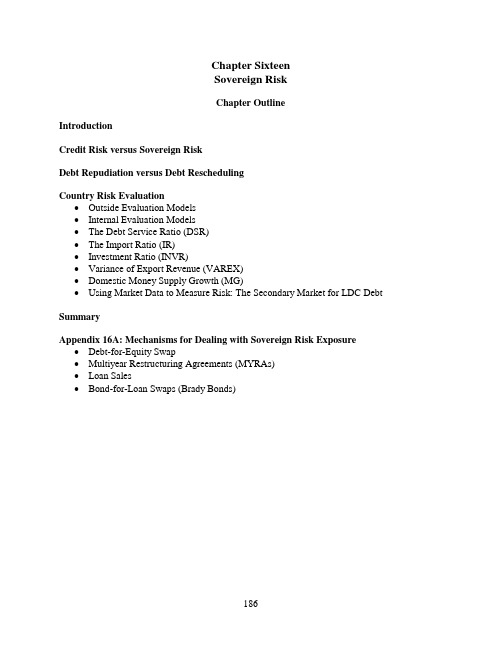
Chapter SixteenSovereign RiskChapter OutlineIntroductionCredit Risk versus Sovereign RiskDebt Repudiation versus Debt ReschedulingCountry Risk Evaluation∙Outside Evaluation Models∙Internal Evaluation Models∙The Debt Service Ratio (DSR)∙The Import Ratio (IR)∙Investment Ratio (INVR)∙Variance of Export Revenue (VAREX)∙Domestic Money Supply Growth (MG)∙Using Market Data to Measure Risk: The Secondary Market for LDC Debt SummaryAppendix 16A: Mechanisms for Dealing with Sovereign Risk Exposure ∙Debt-for-Equity Swap∙Multiyear Restructuring Agreements (MYRAs)∙Loan Sales∙Bond-for-Loan Swaps (Brady Bonds)Solutions for End-of-Chapter Questions and Problems: Chapter Sixteen1. Explain what risks are incurred when making loans to borrowers based in foreign countries? When making loans to borrowers in foreign countries, two risks need to be considered. First, the credit risk of the project needs to be examined to determine the ability of the borrower to repay the money. This analysis is based strictly on the economic viability of the project and is similar in all countries. Second, unlike domestic loans, creditors are exposed to sovereign risk. Sovereign risk is defined as the uncertainty associated with the likelihood that the host government may not make foreign exchange available to the borrowing firm to fulfil its payment obligations. Thus, even though the borrowing firm has the resources to repay, it may not be able to do so because of actions beyond its control. Thus, creditors need to account for sovereign risk in their decision process when choosing to invest abroad.2. What is the difference between debt rescheduling and debt repudiation?Loan repudiation refers to a situation of outright default where the borrower refuses to make any further payments of interest and principal. In contrast, loan rescheduling refers to temporary postponement of payments during which time new terms and conditions are agreed upon between the borrower and lenders. In most cases, these new terms are structured to make it easier for the borrower to repay.3. Identify and explain at least four reasons why rescheduling debt in the form of loans iseasier than rescheduling debt in the form of bonds.The reasons why it is easier to reschedule debt in the form of bank loans than bonds, especially in the context of post-war lending in international financial markets, include:a) Loans usually are made by a small group (syndicate) of banks as opposed to bonds that areheld by individuals and institutions that are geographically dispersed. Even thoughbondholders usually appoint trustees to look after their interests, it has proven to be much more difficult to approve renegotiation agreements with bondholders in contrast to banksyndicates.b) The group of banks that dominate lending in international markets is limited and hence ableto form a cohesive group. This enables them to act in a unified manner against potentialdefaults by countries.c) Many international loans, especially those made in the post-war period, contain cross-default clauses, which make the cost of default very expensive to borrowers. Defaulting ona loan would trigger default clauses on all loans with such clauses, preventing borrowersfrom selectively defaulting on a few loans.d) In the case of post-war loans, governments were reluctant to allow banks to fail. This meantthat they would also be actively involved in the rescheduling process by either directlyproviding subsidies to prevent repudiations or providing incentives to internationalagencies like the IMF and World Bank to provide other forms of grants and aid.4. What three country risk assessment models are available to investors? How is each modelcompiled?The Euromoney Index was originally published as the spread of the Euromarket interest rate for a particular country’s debt over LIBOR. The index was adjusted for volume and maturity. The index recently has been replaced by a large number of subjectively determined economic and political factors.The Economist Intelligence Unit (EIU) combines economic and political risk to achieve a risk rating of a country. The measure is based on a 100 point scale with ratings of smaller risk being lower values.The Institutional Investor Index is based on surveys of the loan officers of major multinational FIs who subjectively give estimates of the credit quality of given countries. The scores range from 0 for certain default to 100 for no probability of default.5. What types of variables normally are used in a CRA Z-score model? Define the followingratios, and explain how each is interpreted in assessing the probability of rescheduling. The models typically use micro- and macroeconomic variables that are considered important in explaining the probability of a country’s credit reschedul ing.a. Debt service ratio. The debt service ratio (DSR) divides interest plus amortization ondebt by exports. Because interest and debt payments normally are paid in hardcurrencies generated by exports, a larger ratio is interpreted as a positive signal of apending debt rescheduling possibility.b. Import ratio. The import ratio (IR) divides total imports by total foreign exchangereserves. A growing amount of imports relative to FX reserves indicates a greaterprobability of credit restructuring. This ratio is positively related to debt rescheduling.c. Investment ratio. The investment ratio (INVR) measures the investment in real orproductive assets relative to gross national productive. A larger investment ratio isconsidered a signal that the country will be less likely to require rescheduling in thefuture because of increased productivity; thus the relationship is negative. However,because the bargaining position of the country will be enhanced, some observers feelthat the relationship is positive. That is, a stronger ratio gives the country more powerto request, even demand, rescheduling to achieve even better terms on its debt.d. Variance of export revenue. Export revenues are subject to both quantity and price riskdue to demand and supply factors in the international markets. Increased variance isinterpreted as a positive signal that rescheduling will occur because of the decreasedcertainty that debt payments will be made on schedule.e. Domestic money supply growth. Rapid domestic money supply growth indicates anincrease in inflationary pressures that typically means a decrease in the value of thecurrency in international markets. Thus, real output often is negatively impacted, andthe probability of rescheduling increases.6. An FI manager has calculated the following values and weights to assess the credit risk andlikelihood of having to reschedule the loan. From the Z-score calculated from theseweights and values, is the manager likely to approve the loan? Validation tests of the Z-score model indicated scores below 0.500 likely to be nonreschedulers, while scores above0.700 indicated a likelihood of rescheduling. Scores between 0.500 and 0.700 do notpredict well.CountryVariable Value WeightDSR 1.25 0.05IR 1.60 0.10INVR 0.60 0.35VAREX 0.15 0.35MG 0.02 0.15Z = 0.05DSR + 0.15IR + 0.30INVR + 0.35VAREX + 0.15MG= 0.05(1.25) + 0.15(1.60) + 0.30(0.60) + 0.35(0.15) + 0.15(0.02)= 0.488This score classifies the borrower as a probable nonrescheduler.7. Countries A and B have exports of $2 and $6 billion, respectively. The total interest andamortization on foreign loans for both countries are $1 and $2 billion, respectively.a. What is the debt service ratio (DSR) for each country?DSR =ExportsTotal onAmortizatiPlusInterestDSR A = $1/$2 = 0.50 DSR B = $2/$6 = 0.33b. Based only on this ratio, to which country should lenders charge a higher risk premium? Based on the above information, lenders should charge a higher risk premium on loans to Country A because it has more interest and amortization payments due as a percentage of total exports.c. What are the shortcomings of using only these ratios to determine your answer in (b)?This is a very static model and such a preliminary conclusion could be misleading. It is also necessary to consider other factors which may be more favorable for Country A. Looking forward, it is also possible that Country A may be at its developing stage where imports and loans are needed to increase future exports. Historically, most of the industrializedcountries were net importers of capital during their developing stages. Without acomprehensive analysis of the fundamentals, it is not possible to judge the quality of the borrower.8. Explain the following relation:p = f (IR, INVR)+, + or -p = Probability of reschedulingIR = Total imports / total foreign exchange reservesINVR = Real investment/GNPThis relation states that the probability of a country’s rescheduling of its foreign debt is a positive function of IR but it may be positively or negatively related to INVR:IR = Total imports/Total FX reserves. If imports as a percentage of FX reserves increase, it leaves less foreign exchange for payments of debt. As a result, there is a higherlikelihood that the country may have to reschedule its debt.INVR = Real investment/GNP. If a country has higher savings and higher investments, it should lead to higher growth, reducing the likelihood of rescheduling. This supports thenegative sign of the relationship. On the other hand, it is possible that the higher growth puts the country in a stronger bargaining position with its lenders and, consequently, itmay be less intimidated by the threat of default. This may make the likelihood ofrescheduling higher, suggesting a positive relationship between p and INVR.9. How do price and quantity risks affect the variability of a country’s export revenue?Quantity risk refers to the variability in the amount of a commodity produced. This is most likely to be found in agricultural products subject to favorable and unfavorable weather conditions. Price risk refers to the variability in the commodity price due to changes in market conditions, e.g., competitors’ supply changes or consumer demand changes.10. The average σ2ER (or VAREX = variance of export revenue) of a group of countries hasbeen estimated at 20 percent. The individual VAREX of two countries in the group,Holland and Singapore, has been estimated at 15 percent and 28 percent, respectively. The regression of individual country VAREX on the average VAREX provides the following beta (coefficient) estimates:βH = Beta of Holland = 0.80; βS = Beta of Singapore = 0.20.a. Based only on the VAREX estimates, which country should be charged a higher riskpremium? Explain.Based on the VAREX measure alone, risk premiums should be lower for loans made to the Netherlands because its VAREX is lower than Singapore’s. VAREX measures thevolatility of the export revenues and is one measure of the ability of countries to repayforeign debt.b. If FIs include systematic risk in their estimation of risk premiums, how would yourconclusions to part (a) be affected? Explain.Since the systematic beta of Singapore is lower than that of the Netherlands, it will reduce the overall systematic risk of an FI’s portfolio of foreign loans. In this case, it benefits the FI to add Singapore to its list of countries because its unsystematic risk can be diversified away. Thus, if the industrialized countries, including the Netherlands, are experiencing a recession and a decline in export revenues, Singapore’s exports are likely to be unaffected as evidenced by the low beta. This implies that the debt repayments between these twocountries are not highly correlate d, helping to reduce the bank’s total risk.11. What shortcomings are introduced by using traditional CRA models and techniques? Ineach case, what adjustments are made in the estimation techniques to compensate for the problems?The following six items often are listed as problems in using these statistical models. First, measuring the variables accurately and in a timely manner often is difficult because of data accessibility. These errors are further impacted by normal forecast errors that occur with the use of statistical models.Second, the choice of rescheduling or not rescheduling often is not a dichotomous situation. In effect, many other payment alternatives may be available through negotiation. Further, the reasons for nonpayment should be evaluated when classifying risk.Third, political risk factors are extremely difficult to quantify. One attempt to quantify political risk is the Index of Economic Freedom that includes measures of various activities that are considered to be related to the lack of government constraint or restriction. The index has a value of 1 to 5, with 1 indicating the most economic freedom. An alternative measure is the Corruption Perceptions Index which provides a similar measure, although the scale ranges from 0 to 10 and is reversed.Fourth, the portfolio affects of lending to more than one country are not considered. Thus the true amount of systematic risk added to the portfolio may be less than estimated by evaluating the rescheduling probability of countries independently. If an economic variable has a small systematic risk component relative to the unsystematic portion, the variable may be considered of little importance since its impact can be diversified away.Fifth, statistical models are ill-prepared or designed to evaluate the incentives of both theborrowers and the lenders to negotiate a rescheduling of the debt. Borrowers benefit by lowering the present value of future payments at the expense of reducing the openness of the market to future borrowing as well as withstanding potentially adverse effects on trade. Lenders benefit by avoiding a possible default, collecting additional fees, and perhaps realizing tax benefits. Lenders, however, may also be subject to greater scrutiny by regulatory authorities and may have permanent changes in the maturity structure of their asset portfolios.Finally, many of the key variables suffer from the problem of stability. That is, predictive performance in the past may not be a good indicator of predictive performance in the future. This implies that CRA models continuously must be updated.12. What is systematic risk in terms of sovereign risk? Which of the variables often used instatistical models tend to have high systematic risk? Which variables tend to have lowsystematic risk?Systematic risk refers to the risk effects that cannot be diversified away by lending to more than one country. In effect, some international economic situations will affect the economies of less developed countries in a similar manner. Economic research indicates that the DSR and the VAREX both have high systematic risk elements. Money supply growth and the import ratio seem to have low systematic risk elements.13. What are the benefits and costs of rescheduling to the following?a. A borrower?Benefits and costs to the borrower: (a) It could reduce its immediate payments and increase imports for the present. It could also reduce the overall payments, depending on therescheduling agreements. (b) It could result in either no loans being approved in the future or the imposition of more stringent requirements. It could also result in higher premiums on other trade instruments, such as letters of credit.b. A lender?Benefits and costs to the lenders: (a) It improves the likelihood that the lender will receive full payment of its interest and principal as opposed to an outright default. (b) Therestructured loan, on a present value basis, may be higher then the existing present value of the loan. (c) There may be tax advantages to writing off some portions of the loan, so the present value of the complete package may be higher than the current present value of the loan. (d) Banks may be stuck holding loans that are of longer maturity with higher risk.e) Reschedu led loans may be a burden on the lender’s remaining assets, and markets maypenalize the lender for holding on to loans that are hard to dispose of.14. Who are the primary sellers of LDC debt? Who are the buyers? Why are FIs often bothsellers and buyers of LDC debt in the secondary markets?The primary sellers of LDC debt include large FIs who are willing to accept write-downs of loans and small FIs who no longer wish to be involved with the LDC market. Buyers tend to be wealthy investors, hedge funds, FIs, and corporations who wish to use debt-equity swaps to further investment goals. FIs that are both buyers and sellers often do so to readjust their balance sheets to meet corporate goals.15. Identify and describe the four market segments of the secondary market for LDC debt.Brady bonds are recollateralized loans that have lower coupon interest rates and longer maturities than the original loans. The principal usually is collateralized with the purchase of U.S. treasury bonds by the issuing country. Although yields are lower, the Brady bonds have more acceptability in the secondary markets than the original loans.Sovereign bonds constitute the second largest segment of the LDC debt market. These bonds are issued to repay Brady bonds, and thus they have higher credit risk premiums because they no longer have the cost of the U.S. treasury collateral.Performing loans are the original or restructured sovereign loans on which the originating country continues to remain current in the payment of interest and principal.Nonperforming loans are traded in the secondary markets at deep discounts because of nonpayment situations.The following questions and problems are based on material presented in Appendix 16-A.16. What are the risks to an investing company participating in a debt-equity swap?Debt-equity swap investors often face long periods before they can repatriate dividends, often have large withholding tax restrictions, have the long-term problem of potential expropriation or nationalization of assets, and face significant foreign exchange currency risk.17. Chase Bank holds a $200 million loan to Argentina. The loans are being traded at bid-offerprices of 91-93 per 100 in the London secondary market.a. If Chase has an opportunity to sell this loan to an investment bank at a 7 percentdiscount, what are the savings after taxes compared with selling the loan in thesecondary market? Assume the tax rate is 40 percent.The price that Chase could obtain from the investment bank is $200(1 – 0.07) = $186m.The tax loss benefit is $14m x 0.40 = $5.6m, for a net price of $186m + $5.6 = $191.60.In the secondary market, it would have had to sell the loans at 91cents on the dollar or $182 million. The tax loss benefit is $18m x 0.40 = $7.2m for a net price of $189.20. Therefore, the savings from selling the loans to the investment bank as opposed to the secondarymarket is $191.60 - $189.20 = $2.4 million.b. The investment bank in turn sells the debt at a 6 percent discount to a real estatecompany planning to build apartment complexes in Argentina. What is the profit aftertaxes to the investment bank?The investment bank purchased the loan for $186 million, and it sells the loan for $188million ($200m(1 – 0.06) = $188m). Thus profit before taxes is $188 - $186 = $2 million, and profit after taxes is $2(1 - 0.40) = $1.20 million.c. The real estate company converts this loan into pesos under a debt-equity swaporganized by the Argentinean government. The official rate for dollar to pesoconversion is P1.05/$. The free market rate is P1.10/$. How much did the real estatecompany save by investing in Argentina through the debt-equity swap program asopposed to directly investing $200 million using the free market rates?If the real estate company had invested directly, it would have received $200 x 1.10 = 220 million pesos. By purchasing through the debt-equity swap, the company pays $188 million and receives $200 x 1.05 = 210 million pesos, for an equivalent rate of 210/188 = P1.117/$.Thus, it still saves by purchasing through the debt-for-equity swap (P1.117/$ > P1.10/$).d. How much would Chase benefit from doing a local currency debt-equity swap itself?Why doesn’t the bank do this swap?Assuming the bank could convert the loan at $188 million in to pesos at P1.05/$, the after tax effect would be $188m plus the tax loss benefit = $188m + $12(0.40) = $192.8 million.The actual benefit was $191.6 million. Thus the bank would gain $1.2 million.Chase is not allowed to participate in real equity purchases in other countries by Federal Reserve Regulation K, nor is it allowed to engage in commerce in other countries. Further,a long-term pesos-denominated position on the balance sheet may create more credit,liquidity, and foreign exchange risk than the benefits are worth.18. Zlick Company plans to invest $20 million in Chile to expand its subsidiary’smanufacturing output. Zlick has two options. It can convert the $20 million at the current exchange rate of 410 pesos to a dollar, (i.e., P410/$), or it can engage in a debt-equity swap with its bank, City Bank, by purchasing Chilean debt and then swapping that debt intoChilean equity investments.a. If City Bank quotes bid-offer prices of 94-96 for Chilean loans, what is the bankexpecting to receive from Zlick Corporation (ignore taxes)? Why would City Bankwant to dispose of this loan?City Bank expects to receive 96 cents to the dollar since it is selling this loan, i.e. 0.96 x 20m = $19.20 million. It may wish to sell this loan to reduce its portfolio of troubled or bad quality assets. As U.S. banks experienced problems with several of their foreign loans, their choices were limited to either writing off the loans or disposing of them. The development of an active secondary market has made it easier for FIs to sell them at a discount andrearrange their composition of loans.b. If Zlick decides to purchase the debt from City Bank and convert it to equity, it willhave to exchange it at the official rate of P400/$. Is this option better than investingdirectly in Chile at the free market rate of P410/$?If exchanged at market rates: $20m x P410 = P8,200 million, for an effective rate of P410/$.If exchanged through a debt-for-equity swap: $20m x P400 = P8,000 million, for aneffective price of 8,000/19.20 = P416.67/$. Therefore, Zlick should choose the debt-for-equity swap option.c. What official exchange rate will cause Zlick to be indifferent between the two options?For the options to be equal, the effective price must be:(20 * x)/19.20 = 410 => x = (410 x 19.20)/20 = P393.60/$The Chilean government could reduce the official rate to as low as P393.60/$ and the two options will still be equal. This is because the discount obtained from the secondary market is substantial.19. What is concessionality in the process of rescheduling a loan?Concessionality refers to the net cost to the FI in restructuring a loan. The amount of concessionality is determined by subtracting the present value of the restructured loan from the present value of the original loan.20. Which variables typically are negotiation points in an LDC multiyear restructuringagreement (MYRA)? How do changes in these variables provide benefits to the borrower and to the lender?The five common elements typically found in the MYRA negotiation include:(a) A fee charged by the bank to cover the cost of the restructuring.(b) The interest rate on the loan is usually lowered to allow easier repayment of the loan by theborrowing country.(c) A grace period may be created to allow the country to build a reserve of hard currency fromwhich it can repay the loan.(d) The maturity of the loan normally is lengthened. This process reduces the periodicpayment stream for the borrower country.(e) Various option and guarantee features may allow the lender to choose the currency forrepayment, and/or to provide protection in the case of default.21. How would the restructuring, such as rescheduling, of sovereign bonds affect the interestrate risk of the bonds? Is it possible that such restructuring would cause the bank’s cost of capital to change? Explain.To the extent that the bonds have increased maturity and lower interest rates, the duration of these bonds will have increased. Thus the interest rate risk will have increased. While it is possible that the bank’s cost of capital will not change, a bank with a significant portion of its assets in LDC debt that has been restructured will likely find an adverse adjustment in its cost of capital.22. A bank is in the process of renegotiating a loan. The principal outstanding is $50 millionand is to be paid back in two installments of $25 million each, plus interest of 8 percent.The new terms will stretch the loan out to 5 years with only interest payments of 6 percent, no principal payments, for the first three years. The principal will be paid in the last two years in payments of $25 million along with the interest. The cost of funds for the bank is 6 percent for both the old loan and the renegotiated loan. An up-front fee of 1 percent is to be included for the renegotiated loan.a. What is the present value of the existing loan for the bank?The present value of the loan prior to rescheduling is:Payment in Year 1: Principal + Interest = $25m + 0.08 * $50 = $29mPayment in Year 2: Principal + Interest = $25m + 0.08 * $25 = $27mPV = PV n=1, k=6 ($29) + PV n=2, k=6 ($27) = $51.3884 millionb. What is the present value of the rescheduled loan for the bank?Interest payments in years 1, 2 and 3: 0.06 x $50 = $3mPayment in Year 4: Principal + Interest = $25m + 0.06 * $50 = $28mPayment in Year 5: Principal + Interest = $25m + 0.06 * $25 = $26.5mPV = PVA n=3, k=6 ($3) + PV n=4, k=6 ($28) + PV n=5, k=6 ($26.5) = $50 millionUp-front fee = 0.01 x $50 = $0.50 millionPV (total) = $50.50 millionc. Is the concessionality positive or negative for the bank?Concessionality = PV o- PV R = PV of old loan - PV of rescheduled loan= $51.3884 - $50.50 = $0.884 million23. A bank is in the process of renegotiating a three-year nonamortizing loan. The principaloutstanding is $20 million, and the interest rate is 8 percent. The new terms will extend the loan to 10 years at a new interest rate of 6 percent. The cost of funds for the bank is 7percent for both the old loan and the renegotiated loan. An up-front fee of 50 basis points is to be included for the renegotiated loan.a. What is the present value of the existing loan for the bank?PV of old loan = PVIFA n=3,k=7%($1.6m) + PVIF n=3,k=7%($20m) = $20.5249 millionb. What is the present value of the rescheduled loan for the bank?PV of new loan = PVIFA n=10,k=7%($1.2m) + PVIF n=10,k=7%($20m) + up-front fee of $0.10m = $18.5953 million + $0.10 million = $18.6953 millionc. What is the concessionality for the bank?Concessionality = $20.5249m - $18.6953m = $1.8296 milliond. What should be the up-front fee to make the concessionality zero?Concessionality = $20.5249m - $18.5953m - x = 0 x = $1.9296 million or 9.65 percent.24. A $20 million loan outstanding to the Nigerian government is currently in arrears with CityBank. After extensive negotiations, City Bank agrees to reduce the interest rates from 10 percent to 6 percent and to lengthen the maturity of the loan to 10 years from the present 5 years remaining to maturity. The principal of the loan is to be paid at maturity. There will no grace period, and the first interest payment is expected at the end of the year.a. If the cost of funds is 5 percent for the bank, what is the present value of the loan priorto the rescheduling?Interest payments in years 1 - 5: 0.10 x $20 = $2mPV = PVA n=5,k=5($2) + PV n=5,k=5($20) = $24.3295 millionb. What is the present value of the rescheduled loan to the bank?Interest payments in years 1 - 10: 0.06 x $20 = $1.2mPV = PVA n=10,k=5($1.2) + PV n=10,k=5($20) = $21.5443 millionc. What is the concessionality of the rescheduled loan if the cost of funds remains at 5percent and an up-front fee of 5 percent is charged?Up-front fee = 0.05 x $20m = $1 millionPV (total) = $21.5443 million + $1 million = $22.5443 millionConcessionality = PV o- PV R = PV of old loan - PV of rescheduled loan= $24.3259 - $22.5443 = $1.7852 million。
金融金融监管体系配套习题及答案
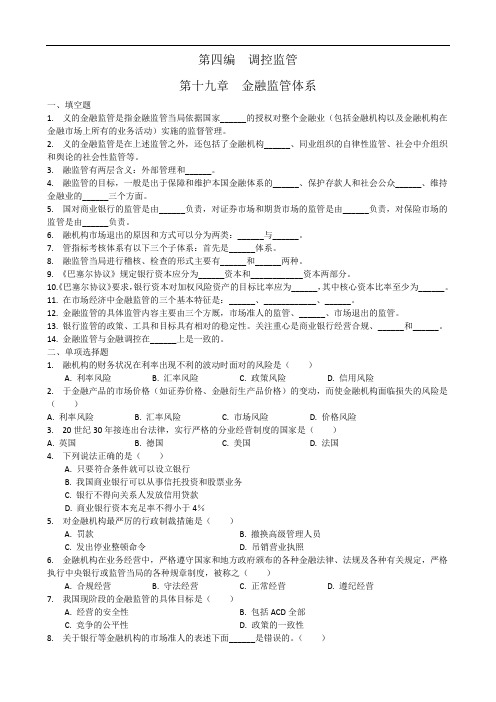
第四编调控监管第十九章金融监管体系一、填空题1. 义的金融监管是指金融监管当局依据国家______的授权对整个金融业(包括金融机构以及金融机构在金融市场上所有的业务活动)实施的监督管理。
2. 义的金融监管是在上述监管之外,还包括了金融机构______、同业组织的自律性监管、社会中介组织和舆论的社会性监管等。
3. 融监管有两层含义:外部管理和______。
4. 融监管的目标,一般是出于保障和维护本国金融体系的______、保护存款人和社会公众______、维持金融业的______三个方面。
5. 国对商业银行的监管是由______负责,对证券市场和期货市场的监管是由______负责,对保险市场的监管是由______负责。
6. 融机构市场退出的原因和方式可以分为两类:______与______。
7. 管指标考核体系有以下三个子体系:首先是______体系。
8. 融监管当局进行稽核、检查的形式主要有______和______两种。
9. 《巴塞尔协议》规定银行资本应分为______资本和____________资本两部分。
10.《巴塞尔协议》要求,银行资本对加权风险资产的目标比率应为______,其中核心资本比率至少为______。
11. 在市场经济中金融监管的三个基本特征是:______、____________、______。
12. 金融监管的具体监管内容主要由三个方厩,市场准人的监管、______、市场退出的监管。
13. 银行监管的政策、工具和目标具有相对的稳定性。
关注重心是商业银行经营合规、______和______。
14. 金融监管与金融调控在______上是一致的。
二、单项选择题1. 融机构的财务状况在利率出现不利的波动时面对的风险是()A. 利率风险B. 汇率风险C. 政策风险D. 信用风险2. 于金融产品的市场价格(如证券价格、金融衍生产品价格)的变动,而使金融机构面临损失的风险是()A. 利率风险B. 汇率风险C. 市场风险D. 价格风险3. 20世纪30年接连出台法律,实行严格的分业经营制度的国家是()A. 英国B. 德国C. 美国D. 法国4. 下列说法正确的是()A. 只要符合条件就可以设立银行B. 我国商业银行可以从事信托投资和股票业务C. 银行不得向关系人发放信用贷款D. 商业银行资本充足率不得小于4%5. 对金融机构最严厉的行政制裁措施是()A. 罚款B. 撤换高级管理人员C. 发出停业整顿命令D. 吊销营业执照6. 金融机构在业务经营中,严格遵守国家和地方政府颁布的各种金融法律、法规及各种有关规定,严格执行中央银行或监管当局的各种规章制度,被称之()A. 合规经营B. 守法经营C. 正常经营D. 遵纪经营7. 我国现阶段的金融监管的具体目标是()A. 经营的安全性B. 包括ACD全部C. 竞争的公平性D. 政策的一致性8. 关于银行等金融机构的市场准人的表述下面______是错误的。
金融学:金融机构体系及其他金融性公司习题与答案
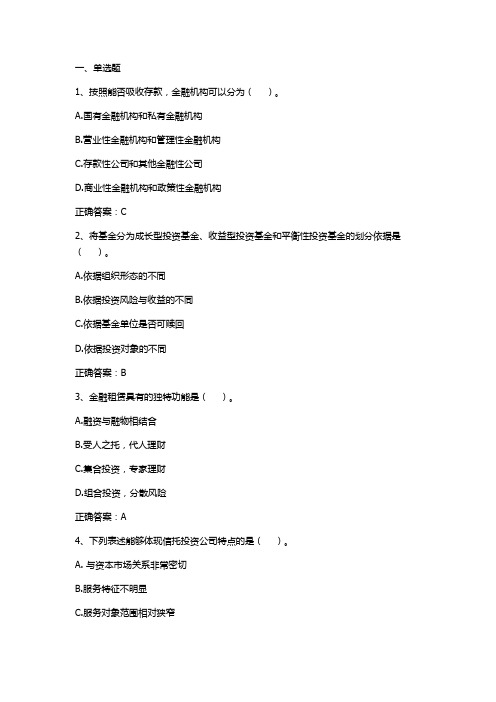
一、单选题1、按照能否吸收存款,金融机构可以分为()。
A.国有金融机构和私有金融机构B.营业性金融机构和管理性金融机构C.存款性公司和其他金融性公司D.商业性金融机构和政策性金融机构正确答案:C2、将基金分为成长型投资基金、收益型投资基金和平衡性投资基金的划分依据是()。
A.依据组织形态的不同B.依据投资风险与收益的不同C.依据基金单位是否可赎回D.依据投资对象的不同正确答案:B3、金融租赁具有的独特功能是()。
A.融资与融物相结合B.受人之托,代人理财C.集合投资,专家理财D.组合投资,分散风险正确答案:A4、下列表述能够体现信托投资公司特点的是()。
A. 与资本市场关系非常密切B.服务特征不明显C.服务对象范围相对狭窄D. 在经营中需要提取准备金正确答案:A5、由中国主导建立的新的国际金融机构是()。
A.亚洲基础设施投资银行B.国际货币基金组织C.国际清算银行D.世界银行集团正确答案:A6、以“受人之托、代人理财”为基本特征的其他金融性公司是()。
A.投资基金B. 证券公司C.保险公司D.信托投资公司正确答案:D7、当今世界号称是“中央银行的中央银行”的国际金融机构是()。
A.国际货币基金组织B.世界银行集团C.亚洲开发银行D.国际清算银行正确答案:D8、开放式基金和封闭式基金的划分依据是()。
A.依据投资对象的不同B.依据组织形态的不同C.依据投资风险与收益的不同D.依据基金单位是否可赎回正确答案:D9、缓解中小企业融资难问题中在中小企业与商业银行之间起增强中小企业信用、防范商业银行信贷风险作用的金融机构是()。
A.金融担保公司B.证券公司C.金融租赁公司D.金融资产管理公司正确答案:A10、投资基金的投资管理中核心内容是()。
A.资产缺口管理B.贷款风险管理C.期限匹配管理D.投资组合管理正确答案:D二、多选题1、现代国家金融机构体系中专业银行的类别有()。
A.进出口银行B. 产业银行和土地银行C.开发银行D.商业银行正确答案:A、B、C2、下列国际金融机构中属于区域性金融机构的是()。
章5.《金融机构体系》习题

第五章《金融机构体系》习题班级姓名学号一、判断题1.()金融机构体系一般可分为中央银行和商业银行两大类。
2.()在多数国家,银行类金融机构在整个金融体系中占有支配性地位。
3.()银行类金融机构与非银行类金融机构划分的最重要的依据在于是否开展证券业务。
4.()银行和非银行金融机构的区别主要在于是否吸收活期存款。
5.()金融机构体系通常包括中央银行和商业银行两类金融机构。
6()早期的高利贷信用是现代银行制度形成的重要途径之一。
7()早期银行只有信用媒介功能而没有信用创造功能。
8()哪种将自由化当做世界银行业发展趋势的说法是对银行业发展趋势的一种曲解或误判。
9()吸收活期存款并非是存款类金融机构的专利。
10.()中央银行是一国金融运作体系的主体。
11.()中央银行是一国最高的货币金融管理机构,在各国金融体系中居于的领导和核心的地位。
12.()其实中央银行并不是一家金融机构,而是国家机器的一个组成部分。
13.()随着金融自由化的发展,现在西方发达国家的中央银行已逐渐成为“金融百货公司”。
14.()其实政策性银行与中央银行一样,它们不以盈利为目的,共同制定和实施货币政策。
15.()政策性银行是重要的专业银行之一。
16.()国有企业和各级政府的存款是政策性银行最主要的资金来源。
17.()不追求盈利是政策性银行最重要的经营特点之一。
18.()中国进出口银行是直属国务院领导的政策性金融机构。
19.()专业银行是指专门经营指定范围业务和提供专门性金融服务的组织。
20.()其实专业银行也就是商业银行。
21.()投资银行是一国专门负责开发性建设项目投融资的专业银行。
22.()商人银行是商业银行早期的称谓。
23.()中国投资银行是迄今为止我国唯一的、真正的投资银行。
24.()西方国家的农业银行具有政策性银行的性质。
25()投资银行也吸收部分存款,但一般限于定期存款,不接受活期性质存款。
26.()开发银行一般都属于政策性银行。
金融学:存款类金融机构习题与答案
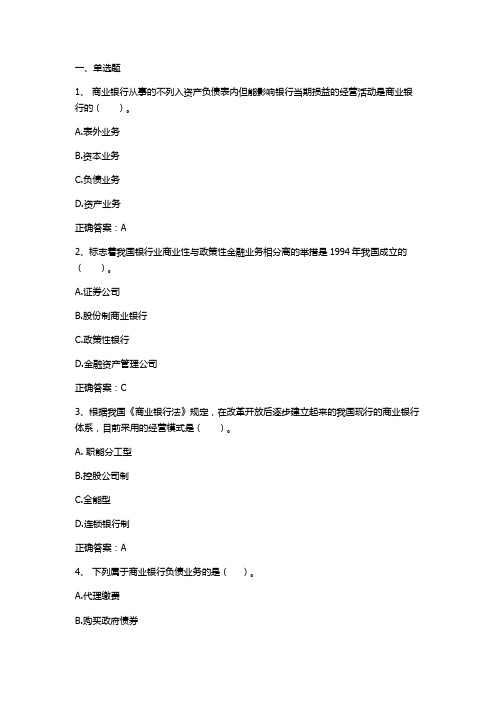
1、商业银行从事的不列入资产负债表内但能影响银行当期损益的经营活动是商业银行的()。
A.表外业务B.资本业务C.负债业务D.资产业务正确答案:A2、标志着我国银行业商业性与政策性金融业务相分离的举措是1994年我国成立的()。
A.证券公司B.股份制商业银行C.政策性银行D.金融资产管理公司正确答案:C3、根据我国《商业银行法》规定,在改革开放后逐步建立起来的我国现行的商业银行体系,目前采用的经营模式是()。
A. 职能分工型B.控股公司制C.全能型D.连锁银行制正确答案:A4、下列属于商业银行负债业务的是()。
A.代理缴费B.购买政府债券D.发行大额可转让定期存单正确答案:D5、由于利率的波动而使商业银行蒙受损失可能性的风险是()。
A.市场风险B.信用风险C. 操作风险D.流动性风险正确答案:A6、不以盈利为目标,但坚持有偿借贷原则,依据国家宏观政策需要,以特定的业务领域为服务对象的金融机构是()。
A.政策性银行B.商业银行C.城市信用社D.投资银行正确答案:A7、商业银行通过存贷款业务所实现的独特功能是()。
A.存款货币的创造B.信息集聚与处理C.金融创新D.风险管理正确答案:A8、属于商业银行负债管理中主动负债的业务是()。
A.吸收存款C.库存现金D.发行债券正确答案:D9、我国商业银行的外部组织形式普遍采用的是()。
A. 总分行制B. 单一制C.连锁银行制D.控股公司制正确答案:A10、存放中央银行和银行同业的存款是商业银行的()。
A.现金资产B. 中间业务C. 信贷资产D.表外资产正确答案:A二、多选题1、商业银行的外部组织形式因各国政治经济制度不同而有所不同,目前主要的类型有()。
A.单一银行制B.复合制C.连锁银行制D.控股公司制正确答案:A、C、D2、商业银行的现金资产主要包括()。
A.存放同业的款项B.存放在中央银行的超额准备金C. 发行大额可转让存单D.库存现金正确答案:A、B、D3、下列有关政策性银行的表述正确的有()。
金融学第一章金融体系习题附答案(最新整理)

第一章金融体系概述一、选择题1、直接融资的优点是:。
A.投资者承担较小的投资风险 B.容易实现资金供求期限和数量的匹配C.有利于降低信息成本和合约成本 D.可以节约交易成本2、直接融资的缺点包括等。
①投资者需要花费大量的搜集信息、分析信息的时间和成本②投资者要承担较大的投资风险③不利于通过分散化来降低金融风险④融资的门槛比较高A.①②③④ B.①③④ C.②③④ D.①②③3、金融机构可通过来筹集资金。
①发行存单②提供贷款③发行债券④发行股票A.①②③ B.①③④ C.①②④ D.①②③④4、以下阐述正确的是。
①金融市场是金融资产交易的场所②金融市场是金融资产的供求关系、交易活动和组织管理等活动的总和③金融市场的发育程度直接影响金融体系功能的发挥④金融市场为有形市场A.②③④ B.①③④ C.①②③ D.①②④5、金融创新包括等在内的创新。
①金融工具②金融市场③金融制度④金融机构A.①②③ B.①③④ C.②③④ D.①②③④6、的金融创新对传统的金融市场和体制带来巨大冲击。
A.20世纪50年代 B.离岸金融市场—欧洲货币市场的建立C.18世纪英国中央银行制度的建立 D.20世纪70年代不断涌现7、当代金融创新的直接导因是。
①国际资本的加速流动②世界范围的放松金融管制③国际债务危机的爆发和影响④电子计算机技术和网络技术在金融领域的广泛应用A.①②③④ B.②④ C.②③④ D.①③④8、以下哪一选项不是金融创新所能产生的积极作用?A.金融创新扩大了金融机构的资金来源渠道,扩大了金融服务业务领域B.有利于发挥利率杠杆在调节金融资源配置中的作用C.能降低金融系统的风险D.有利于世界金融和经济的深化发展9、金融市场创新不包括:A.市场种类的创新 B.市场组织形式的创新C.市场制度的创新 D.汇率制度的创新10、金融工具的创新具体包括:①时间衍生②功能衍生③种类衍生④复合衍生A.①②③④ B.以上都不是 C.①②④ D.②③④11、以下对金融资产的描述不正确的是A.市场价值稳定 B.是一种无形资产C.是一种未来收益的索取权 D.市场价值受市场供求状况影响二、判断题1、在现代经济条件下,资金的流动主要是通过金融体系来实现的。
中级经济师金融第三章金融机构与金融制度习题及答案

第三章金融机构与金融制度一、单项选择题1、()是专门吸收居民储蓄存款,将资金主要投资于政府债券和公司股票、债券等金融工具,并为居民提供其他金融服务的金融机构。
A、商业银行B、储蓄银行C、信用合作社D、政策性银行2、按照(),金融机构可分为银行和非银行金融机构。
A、融资方式的不同B、从事金融活动的目的不同C、金融机构业务的特征D、是否承担政策性业务3、政策性银行与商业银行的最显著不同在于()。
A、是否以盈利为目的B、是否执行国家金融政策C、是否自主经营D、是否政府出资4、如果在总行之下设立若干机构,形成以总行为中心的银行网络系统,则该商业银行组织制度是()。
A、一元式银行制度B、综合式银行制度C、分支式银行制度D、分支经营银行制度5、由某一个人或某一集团通过购买两家或更多的银行多数股票的形式,形成联合经营的银行组织制度称为()制度。
A、持股公司B、连锁银行C、分支银行D、单一银行6、世界银行集团由世界银行、国际开发协会和国际金融公司组成,向成员国提供金融服务和技术援助,本质上属于()。
A、金融监管机构B、契约性金融机构C、存款性金融机构D、开发性金融机构7、()成为新中国成立以来的第一家股份制商业银行。
A、交通银行B、深圳发展银行C、中国民生银行A、中国工商银行B、招商银行C、银河证券D、中国农业发展银行9、1999年7月以后,根据《中华人民共和国证券法》,目前我国的经纪类证券公司能从事的证券业务是()。
A、承销B、发行C、自营买卖D、交易中介10、我国为企业集团成员单位提供财务管理服务的非银行金融机构是()。
A、信托投资公司B、财务公司C、小额贷款公司D、金融租赁公司11、我国小额贷款公司从银行业金融机构获得融入资金的余额,不得超过其资本净额的()。
A、50%B、75%C、100%D、125%12、对我国期货结算机构进行监管的金融监管机构是()。
A、中国人民银行B、中国证监会C、中国保监会D、中国银监会13、()是指政策性金融机构在经营活动中要注重资产安全。
金融学(金融机构体系)习题与答案
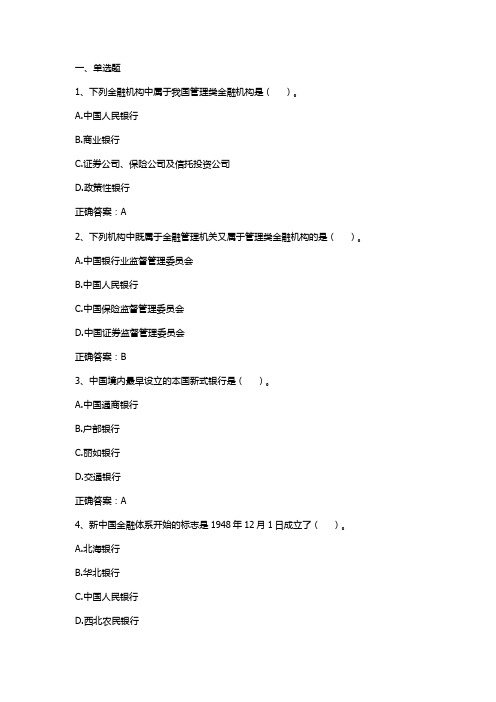
1、下列金融机构中属于我国管理类金融机构是()。
A.中国人民银行B.商业银行C.证券公司、保险公司及信托投资公司D.政策性银行正确答案:A2、下列机构中既属于金融管理机关又属于管理类金融机构的是()。
A.中国银行业监督管理委员会B.中国人民银行C.中国保险监督管理委员会D.中国证券监督管理委员会正确答案:B3、中国境内最早设立的本国新式银行是()。
A.中国通商银行B.户部银行C.丽如银行D.交通银行正确答案:A4、新中国金融体系开始的标志是1948年12月1日成立了()。
A.北海银行B.华北银行C.中国人民银行D.西北农民银行5、由中国主导建立的新的国际金融机构是()。
A.国际货币基金组织B.世界银行集团C.国际清算银行D.亚洲基础设施投资银行正确答案:D6、当今世界号称是“中央银行的中央银行”的国际金融机构是()。
A.亚洲开发银行B.世界银行集团C.国际清算银行D.国际货币基金组织正确答案:C7、金融机构划分为营业性金融机构和管理性金融机构所依据的标准是其()。
A. 业务性质的不同B. 经营规模的大小C. 职能作用的差异D. 能否吸收存款正确答案:C8、管理性金融机构与金融管理机关的最主要区别是()。
A. 是否从事特定的金融业务B. 是否以贯彻落实政府的经济政策为目标C. 是否具有金融管理职能D. 是否以营利为目的9、下列国际金融机构中历史最悠久、现在还在运营的国际金融机构是()。
A.亚洲基础设施投资银行B.国际清算银行C.非洲开发银行D.泛美开发银行正确答案:B10、目前港元最大的发钞银行是()。
A.中国银行B.中国工商银行C.汇丰银行D.英格兰银行正确答案:C二、多选题1、中国在1984年形成了以中国人民银行为核心,以下列四大专业银行为主体、其它各种金融机构并存和分工协作的金融机构体系()。
A.中国建设银行B.中国银行C.中国工商银行D.中国交通银行正确答案:A、B、C2、下列国际金融机构中属于区域性金融机构的是()。
《金融市场和金融机构》课后习题答案解析

《金融市场与金融机构》米什金第七版课后习题答案
(请集中复习1-6、10-13、15章)
第一章为什么研究金融市场与金融机构
第二章金融体系概览
第三章利率的含义及其在定价中的作用
第四章为什么利率会变化
第五章利率的风险结构和期限结构如何影响利率
第六章金融市场是否有效
第十章货币政策传导:工具、目标战略和战术
第七版中的12题在第五六版中没有,此处的12-19题即为第七版的13-20题
第十一章货币市场
第十二章债券市场
第十三章股票市场
第十四章抵押贷款市场
第十五章外汇市场。
中级经济师-金融-基础练习题-新版-第3章金融机构与金融制度体系-第3节我国的金融机构与金融制度体系

中级经济师-金融-基础练习题-新版-第3章金融机构与金融制度体系-第3节我国的金融机构与金融制度体系[单选题]1.证券登记结算公司的具体职能是()A.推销政府债券、企业债券和股票B.参与(江南博哥)企业并购、兼并C.对证券和资金进行清算、交收和过户D.为证券的集中和有组织的交易提供场所、设施正确答案:C参考解析:本题考查证券登记结算公司的具体职能。
证券登记结算公司的具体职能是:对证券和资金进行清算、交收和过户,使买入者得到证券、卖出者得到资金。
[单选题]2.中国人民银行作为我国的中央银行,代表政府进行金融宏观调控,其一个重要的职责是()A.对政府贷款B.再贷款C.经理国库D.再贴现正确答案:C参考解析:中国人民银行作为我国的中央银行,享有人民币发行的垄断权,管理人民币流通,它是发行的银行;中国人民银行代表政府进行金融宏观调控,维护国家金融稳定与安全,经理国库,是政府的银行;中国人民银行负责全国支付、清算系统的正常运行,承担最后贷款人的责任,是银行的银行。
中国人民银行的性质决定了它的特殊地位。
根据法律规定,它在国务院的领导下依法独立执行货币政策,履行职责,开展业务,不受地方政府、各级政府部门、社会团体和个人的干涉。
按照法律规定,中国人民银行具有相对独立性:财政不得向中国人民银行透支;中国人民银行不得直接认购、包销国债和其他政府债券;不得向地方政府、各级政府部门提供贷款。
[单选题]3.中国银行间市场交易商协会的业务主管部门为()。
A.中国人民银行B.证监会C.银保监会D.国务院正确答案:A参考解析:本题考查中国银行间市场交易商协会。
中国银行间市场交易商协会是经国务院、民政部批准成立的全国性的非营利性社会团体法人,其业务主管部门为中国人民银行。
[单选题]5.在特定时期,我国政府为解决银行业不良资产,由政府出资专门收购和集中处置银行业不良资产的机构是()。
A.银保监会B.证监会C.金融租赁公司D.金融资产管理公司正确答案:D参考解析:本题考查金融资产管理公司的概念。
金融学习题集答案
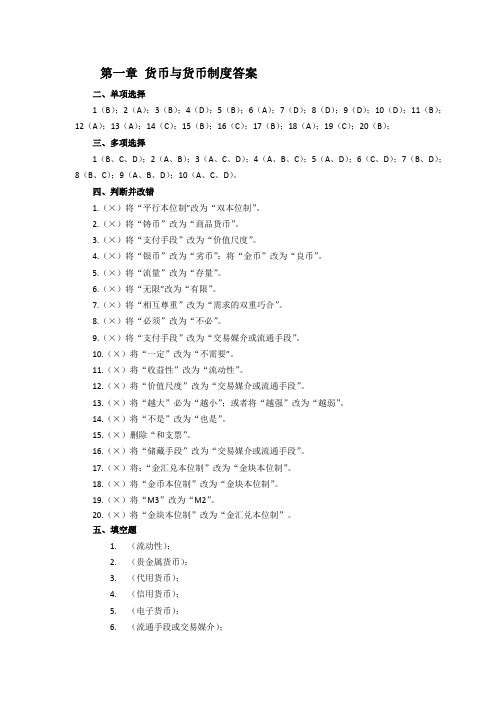
第一章货币与货币制度答案二、单项选择1(B);2(A);3(B);4(D);5(B);6(A);7(D);8(D);9(D);10(D);11(B);12(A);13(A);14(C);15(B);16(C);17(B);18(A);19(C);20(B);三、多项选择1(B、C、D);2(A、B);3(A、C、D);4(A、B、C);5(A、D);6(C、D);7(B、D);8(B、C);9(A、B、D);10(A、C、D)。
四、判断并改错1.(×)将“平行本位制”改为“双本位制”。
2.(×)将“铸币”改为“商品货币”。
3.(×)将“支付手段”改为“价值尺度”。
4.(×)将“银币”改为“劣币”;将“金币”改为“良币”。
5.(×)将“流量”改为“存量”。
6.(×)将“无限”改为“有限”。
7.(×)将“相互尊重”改为“需求的双重巧合”。
8.(×)将“必须”改为“不必”。
9.(×)将“支付手段”改为“交易媒介或流通手段”。
10.(×)将“一定”改为“不需要”。
11.(×)将“收益性”改为“流动性”。
12.(×)将“价值尺度”改为“交易媒介或流通手段”。
13.(×)将“越大”必为“越小”;或者将“越强”改为“越弱”。
14.(×)将“不是”改为“也是”。
15.(×)删除“和支票”。
16.(×)将“储藏手段”改为“交易媒介或流通手段”。
17.(×)将:“金汇兑本位制”改为“金块本位制”。
18.(×)将“金币本位制”改为“金块本位制”。
19.(×)将“M3”改为“M2”。
20.(×)将“金块本位制”改为“金汇兑本位制”。
五、填空题1.(流动性);2.(贵金属货币);3.(代用货币);4.(信用货币);5.(电子货币);6.(流通手段或交易媒介);7.(观念上);8.(币材或货币材料);9.(双本位制);10.(跛行本位制);第二章信用与信用工具答案二、单项选择1(D);2(D);3(B);4(B);5(B);6(B);7(C);8(A);9(A);10(C);11(A);12(C);13(A);14(B);15(B);16(A);17(C);18(C);19(D);20(C);三、多项选择1(A、B);2(A、B、C、D、E);3(A、B);4(A、B、C);5(A、B、C、D);6(A、B、D);7(A、D);8(B、C);9(A、B、D);10(A、B、C)。
金融机构与金融市场练习题及答案一

金融机构与金融市场练习题及答案一1、()是金融市场上最重要的主体。
a.政府b.家庭c.机构投资者d.企业正确答案是:企业2、在经济系统中引导资金流向、使资金由盈余部门向短缺部门转移的市场是()。
a.资本市场b.要素市场c.产品市场d.金融市场正确答案是:金融市场3、()是指以期限在一年以内的金融工具为交易对象的短期金融市场。
a.债券市场b.货币市场c.股票市场d.资本市场正确答案是:货币市场4、()又称柜台市场,是指未上市的证券或不足一个成交批量的证券进行交易的市场。
店头市场以“柜台”和店内交易为特征。
a.议价市场b.店头市场c.公开市场d.第四市场正确答案是:店头市场5、金融工具的重要特性为期限性、收益性、流动性和安全性。
关于金融工具四个特性,下列说法错误的是()。
b.正是期限性、流动性、安全性和收益性相互间的不同组合导致了金融工具的丰富性和多样性,使之能够满足多元化的资金需求和对“四性”的不同偏好。
c.一般来说,流动性、安全性与收益性成反向相关,安全性、流动性越高的金融工具其收益性越低。
d.一般来说,期限性与收益性正向相关,即期限越长,收益越高。
正确答案是:一般来说,期限性与收益性负向相关,即期限越长,收益越低。
6、家庭在金融市场中的主要活动领域是()。
a.黄金市场b.资本市场c.货币市场d.外汇市场正确答案是:资本市场7、金融市场中最主要的经纪人有()a.货币经纪人b.证券承销人c.证券经纪人d.黄金经纪人e.外汇经纪人正确答案是:货币经纪人,证券经纪人,黄金经纪人,外汇经纪人8、证券公司具有以下职能()a.管理金融工具交易价格b.充当证券市场重要的投资人c.充当证券市场中介人d.充当证券市场资金供给者e.提高证券市场运行效率正确答案是:充当证券市场中介人,充当证券市场重要的投资人,提高证券市场运行效率9、金融工具交易或买卖过程中所产生的运行机制,是金融市场的深刻内涵和自然发展,其中最核心的是价格机制,金融工具的价格成为金融市场的要素。
经济师初级金融练习题1501
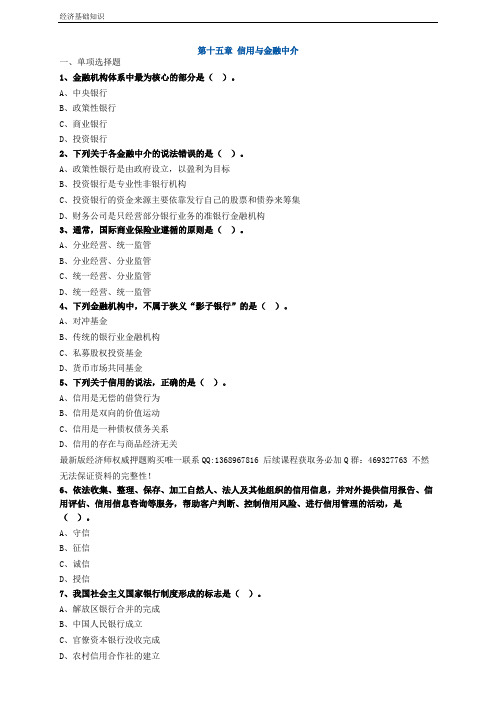
第十五章信用与金融中介一、单项选择题1、金融机构体系中最为核心的部分是()。
A、中央银行B、政策性银行C、商业银行D、投资银行2、下列关于各金融中介的说法错误的是()。
A、政策性银行是由政府设立,以盈利为目标B、投资银行是专业性非银行机构C、投资银行的资金来源主要依靠发行自己的股票和债券来筹集D、财务公司是只经营部分银行业务的准银行金融机构3、通常,国际商业保险业遵循的原则是()。
A、分业经营、统一监管B、分业经营、分业监管C、统一经营、分业监管D、统一经营、统一监管4、下列金融机构中,不属于狭义“影子银行”的是()。
A、对冲基金B、传统的银行业金融机构C、私募股权投资基金D、货币市场共同基金5、下列关于信用的说法,正确的是()。
A、信用是无偿的借贷行为B、信用是双向的价值运动C、信用是一种债权债务关系D、信用的存在与商品经济无关最新版经济师权威押题购买唯一联系QQ:1368967816 后续课程获取务必加Q群:469327763 不然无法保证资料的完整性!6、依法收集、整理、保存、加工自然人、法人及其他组织的信用信息,并对外提供信用报告、信用评估、信用信息咨询等服务,帮助客户判断、控制信用风险、进行信用管理的活动,是()。
A、守信B、征信C、诚信D、授信7、我国社会主义国家银行制度形成的标志是()。
A、解放区银行合并的完成B、中国人民银行成立C、官僚资本银行没收完成D、农村信用合作社的建立8、我国现行的多种金融机构并存的金融中介体系中,居主体地位的金融机构是()。
A、中国人民银行B、中国证券监督管理委员会C、股份制银行D、中国银行保险监督管理委员会9、关于我国现行金融中介体系的说法,错误的是()。
A、中国人民银行是我国的中央银行B、中国进出口银行是政策性银行C、中国光大银行是股份制商业银行D、美国花旗银行北京分行不是我国金融中介体系的组成部分10、某公司发行了一年期债券,这种信用属于()。
A、国家信用B、银行信用C、直接信用D、消费信用11、在当代经济活动过程中,按债权人与债务人结合的特点来划分,信用活动主要分为()。
金融学:金融机构习题与答案
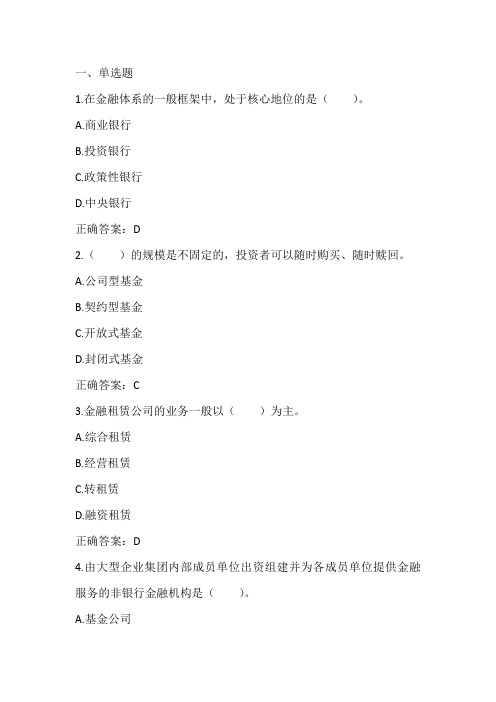
一、单选题1.在金融体系的一般框架中,处于核心地位的是()。
A.商业银行B.投资银行C.政策性银行D.中央银行正确答案:D2.()的规模是不固定的,投资者可以随时购买、随时赎回。
A.公司型基金B.契约型基金C.开放式基金D.封闭式基金正确答案:C3.金融租赁公司的业务一般以()为主。
A.综合租赁B.经营租赁C.转租赁D.融资租赁正确答案:D4.由大型企业集团内部成员单位出资组建并为各成员单位提供金融服务的非银行金融机构是()。
A.基金公司B.投资公司C.资产管理公司D.财务公司正确答案:D5.最早出现的金融机构是()。
A.政策性银行B.信托公司C.商业银行D.投资银行正确答案:C6.下列()不属于存款型金融机构。
A.商业银行B.储蓄银行C.城商行D.投资银行正确答案:D7.下列()不是银行性金融机构。
A.储蓄银行B.政策性银行C.商业银行D.投资银行正确答案:D8.在金融机构体系中处于主体地位的是()。
A.商业银行B.投资银行C.中央银行D.专业银行正确答案:A9.下列属于城市商业银行的是()。
A.渤海银行B.北京银行C.浦东发展银行D.浙商银行正确答案:B10.现代各国商业性金融机构,尤其是银行业,主要是按照()形式建立的。
A.国有制B.私有制C.股份制D.合作制正确答案:C二、多选题1.1999年,我国组建的国有金融资产管理公司有()。
A.华融资产管理公司B.长城资产管理公司C.信达资产管理公司D.东方资产管理公司正确答案:A、B、C、D2.下列属于银行性金融机构的有()。
A.政策性银行B.商业银行C.储蓄银行D.信托公司正确答案:A、B、C3.以下属于非银行性金融机构的有()。
A.商业银行B.保险公司C.证券公司D.信托公司正确答案:B、C、D4.投资基金有许多种类型,按其组织形态不同可分为()。
A.成长型B.封闭型C.开放型D.公司型正确答案:D5.投资基金有许多种类型,按其交易方式不同可分为()。
金融学金融机构习题与答案

金融学金融机构习题与答案一、选择题1、以下不属于金融机构的是()A 商业银行B 证券公司C 财务公司D 工商企业答案:D解析:工商企业主要从事生产经营活动,不是专门从事金融业务的机构。
商业银行、证券公司和财务公司都是以金融业务为核心的机构。
2、金融机构的核心功能是()A 风险管理B 资金融通C 信息提供D 支付结算答案:B解析:资金融通是金融机构最基本、最核心的功能,通过将资金从盈余方转移到短缺方,实现资源的优化配置。
3、以下属于存款类金融机构的是()A 投资银行B 保险公司C 储蓄银行D 信托公司答案:C解析:储蓄银行主要通过吸收公众存款来获取资金,属于存款类金融机构。
投资银行主要从事证券承销等业务,保险公司主要经营保险业务,信托公司主要从事信托业务,它们都不是以吸收存款为主要资金来源。
4、金融机构在金融市场上充当()A 资金需求者B 资金供给者C 中介机构D 以上都是答案:D解析:金融机构在金融市场上既可以是资金需求者,通过发行金融工具筹集资金;也可以是资金供给者,将资金投资于各种金融资产;同时还充当着资金融通的中介机构,促进资金的流动和配置。
5、以下关于中央银行的表述,错误的是()A 是发行的银行B 是银行的银行C 以盈利为目的D 是政府的银行答案:C解析:中央银行不以盈利为目的,而是代表国家制定和执行货币政策,维护金融稳定,为政府提供金融服务。
二、判断题1、金融机构的经营风险比一般企业小。
()答案:错误解析:金融机构经营的是货币资金,面临着信用风险、市场风险、操作风险等多种风险,其经营风险并不比一般企业小。
2、所有金融机构都受到严格的金融监管。
()答案:正确解析:金融机构的业务活动对经济和金融体系的稳定具有重要影响,因此大多数金融机构都受到严格的监管,以防范金融风险和保护投资者利益。
3、商业银行是唯一能够创造存款货币的金融机构。
()答案:错误解析:在现代金融体系中,除了商业银行,中央银行通过货币发行也能创造货币,一些具有类似银行功能的非银行金融机构在一定条件下也可能创造货币。
金融学习题(附答案)

金融学习题(附答案)第二章货币与货币制度一、判断题(正确为√,错误为×)1、货币资产就是传统得、最基本得与最重要得金融资产。
2、中国使用最早与使用时间最长得铸币就是银币。
3、世界上最早得货币就是实物货币。
4、货币成为交易得媒介,提高了交易效率,降低了交易成本.5、电子货币不属于信用货币。
6、货币在地租、借贷以及工资等方面得支付中发挥得职能就是交易媒介。
7、本位币就是一国货币制度法定作为价格标准得基本货币,具有有限法偿效力。
8、世界上最早得纸质货币就是北宋交子。
9、金本位制又可分为金币本位、金块本位与金汇兑本位三种不同得形态,其中以金块本位为最典型得金本位制。
10、称量货币在中国得典型形态就是银两制度.11、辅币得实际价值低于名义价值,具有无限得法偿效力。
12、在现代社会,现金在社会交易额中得使用比例很小,主体就是存款货币。
13、世界各国在对货币进行层次划分时,都以其“流通性”作为依据与标准。
14、定期存款得流动性比股票弱。
15、香港地区得港币发行准备就是美元外汇。
16、世界上最早实行金本位制得国家就是美国。
17、在金本位制下,各国货币得汇率由“金平价”来决定。
18、布雷顿森林体系,实际上就是一个变相得金汇兑本位制。
19、超主权储备货币得出现,能够有效克服“特里芬难题"。
20、港币与澳门币分别由香港中央银行与澳门中央银行发行。
二、单项选择题1、在金属货币制度下,本位币得名义价值与实际价值就是()。
A、呈正比B、呈反比C、相一致D、无关2、辅币得名义价值( )其实际价值.A、高于B、低于C、等于D、不确定3、最早实行金币本位制得国家就是( )。
A、美国B、英国C、法国 D、日本4、辅币得特点( )。
A、就是一种足值货币B、不能自由铸造C、能自由熔化D、就是无限法偿货币5、世界上最早出现得货币制度就是( )。
A、金本位制B、银本位制C、不兑现本位制D、金银复本位制6、当人们在偿还债务、缴纳税赋、借贷款时所使用得货币得职能就是()。
- 1、下载文档前请自行甄别文档内容的完整性,平台不提供额外的编辑、内容补充、找答案等附加服务。
- 2、"仅部分预览"的文档,不可在线预览部分如存在完整性等问题,可反馈申请退款(可完整预览的文档不适用该条件!)。
- 3、如文档侵犯您的权益,请联系客服反馈,我们会尽快为您处理(人工客服工作时间:9:00-18:30)。
金融机构体系》习题、判断题1.()金融机构体系一般可分为中央银行和商业银行两大类。
2.()在多数国家,银行类金融机构在整个金融体系中占有支配性地位。
3.()银行类金融机构与非银行类金融机构划分的最重要的依据在于是否开展证券业务。
4.()银行和非银行金融机构的区别主要在于是否吸收活期存款。
5.()金融机构体系通常包括中央银行和商业银行两类金融机构。
6()早期的高利贷信用是现代银行制度形成的重要途径之一。
7()早期银行只有信用媒介功能而没有信用创造功能。
8()哪种将自由化当做世界银行业发展趋势的说法是对银行业发展趋势的一种曲解或误判。
9()吸收活期存款并非是存款类金融机构的专利。
10.()中央银行是一国金融运作体系的主体。
11.()中央银行是一国最高的货币金融管理机构,在各国金融体系中居于的领导和核心的地位。
12.()其实中央银行并不是一家金融机构,而是国家机器的一个组成部分。
13.()随着金融自由化的发展,现在西方发达国家的中央银行已逐渐成为“金融百货公司”。
14.()其实政策性银行与中央银行一样,它们不以盈利为目的,共同制定和实施货币政策。
15.()政策性银行是重要的专业银行之一。
16.()国有企业和各级政府的存款是政策性银行最主要的资金来源。
17.()不追求盈利是政策性银行最重要的经营特点之一。
18.()中国进出口银行是直属国务院领导的政策性金融机构。
19.()专业银行是指专门经营指定范围业务和提供专门性金融服务的组织。
20.()其实专业银行也就是商业银行。
21.()投资银行是一国专门负责开发性建设项目投融资的专业银行。
22.()商人银行是商业银行早期的称谓。
23.()中国投资银行是迄今为止我国唯一的、真正的投资银行。
24.()西方国家的农业银行具有政策性银行的性质。
25()投资银行也吸收部分存款,但一般限于定期存款,不接受活期性质存款。
26.()开发银行一般都属于政策性银行。
27.()开发银行一般为非营利性机构。
28.()开发银行其实也就是投资银行。
29.()依靠发行股票和债券筹集资金是储蓄银行主要的资金来源。
30.()储蓄银行也就是储蓄所。
31.()储蓄银行的服务对象主要是普通居民。
32.()储蓄银行90%以上的资金来自居民的储蓄存款。
33.()在西方的银行体系中,储蓄银行主要服务于居民的资本性储备需求。
34.()英美国家通常将储蓄银行称之为“信托储蓄银行”35.()以土地为抵押的长期贷款是不动产抵押银行最主要的资金运用方式。
36()保险公司通常将投保人缴纳的保费作为投资资金运作平添了投保人的风险。
37.()信用合作社的资金运用具有封闭性的特点。
38.()租赁公司是一种通过融物形式融资的金融企业。
39.()融资租赁和经营性租赁本质上是一码事。
40.()间接融资机构主要指证券交易所、证券公司等金融中介组织。
41.()交通银行是中国早期四大银行之一。
42.()我国第一家官督商办的银行是1897年成立的交通银行。
43.()中国银行一直来是我国金融机构体系中起领导与核心作用的国家银行。
44.()中国工商银行是新中国最早设立的国家独资的专业银行。
45.()交通银行是现今中国大陆最具实力和影响力的四大国有控股商业银行之一。
46.()现行中国人民银行的分支机构是按省(市、自治区)来设置的。
47.()中国农业银行是我国改革开放后第一家恢复设立的国家级专业银行。
48.()中国民生银行是我国改革开放后第一家完全由企业法人持股的股银行。
49.()招商银行是中国改革开放后第一家由民间资本发起设立的股份制银行50.()中国历史上第一家官督商办的股份制银行是1897年设立的中国通商银行。
51.()交通银行是一家远早于中国工商银行的老牌银行。
52.()中国建设银行是新中国设立的第一家商业银行。
53.()广东发展银行我国改革开放后第一家新设立的、全国性的股份制银行。
54.()中国银行和中国工商银行是我国国有独资商业银行实施股份制改造的最早两家试点银行。
55.()中国银行曾经是新中国建国后专设的外汇专业银行。
56.()随着城市金融体制改革的深入,城市商业银行已完全取代了城市信用合作社,成为中国城市存款类金融机构中一支不可小视的新生力量。
57.()小额贷款公司的最大特点是“只贷不存”。
58.()中国银行业监督管理委员会(简称银监会)的设立,取代了中国人民银行对存款类金融机构的监管职责。
59.()证监会、银监会、保监会等三大金融监管机构的设立意味着人民银行已完成其历史使命,行将退出历史舞台。
60.()按地方行政机构设置原则设立中国人民银行的分支机构符合国际惯例,也便于金融监督管理。
61.()中国人寿保险股份公司是新中国设立的第一家保险公司。
62.()中国人寿保险股份有限公司和中国人民财产保险股份有限公司是从属于中国人民保险公司的两大分公司。
63.()信托公司也就是信托投资公司。
64.()电子化、国际化、自由化是当今国际银行业发展的基本趋势。
65.()存款类金融机构也被之为银行类金融机构。
66.()其实现在的农村合作银行也就是改革开放前的农村信用合作社。
67.()其实小额贷款公司是现阶段我国县域以下地区的新型存款类金融机构。
68.()新中国建国以来,中国人民银行一直就是我国的中央银行。
69.()中国人民银行一度曾是新中国的专业银行。
70.()上海证券交易所是一家不以盈利为目的事业制性质证券类服务机构。
二、单项选择题1.根据现有史料,银行业起源于中世纪的()。
A.荷兰B.意大利C.法国D.英国2.世界上第一家股份制银行——英格兰银行始建于公元(A.1640 年B.1789 年C.1694 年3.英格兰银行的设立标志着(A.银行的产生D.1649 年)。
B.商业银行制度的产生C.中央银行制度的诞生D. 股份制银行的诞生4.下列哪个国家将储蓄银行称之为信托储蓄银行( )A.美国B. 英国C. 法国D. 意大利5.下列哪个国家是世界上邮政储贷最发达的国家。
( )A.美国B. 英国C. 法国D. 日本6.下列哪家是中国近代史上第一家外资背景的股份制银行( )A.麦加利银行B. 汇丰银行C. 丽如银行D. 花旗银行7.中国近代出现的第一家具有现代意义的民族资本银行是( )A. 中国银行B. 交通银行C. 东方银行D. 中国通商银行8.旧中国国民党统治区“四行两局一库”中的所指的“一库”是()A. 中央金库B. 中央银行金库C. 中国银行金库D . 中央信用合作金库9.中国人民银行始建于(C. 1948年 1月1日10. 中国人民银行诞生于( )。
A. 北京 C. 南京11. 下列哪家为新中国第一家商业银行A. 中国银行 C. 中国建设银行12. 下列哪家曾经是新中国历史上唯A. 中国光大银行 C. 招商银行13. 中国工商银行于正式设立于(A. 1949年 10月 1日 C. 1983年 1月1日14. 中国工商银行是改革开放后从() 业银行。
A. 中国银行 C. 中国建设银行15. 改革开放后中国大陆第一家完全由企业法人持股的股份制商业银行是A. 1949年 10月 1日B. 1948年 10月 1日 D. 1948年 12月 1日B. 上海 D. 石家庄)B. 中国工商银行D. 中国农业银行 的外汇专业银行。
()B. 交通银行D. 中国银行)。
B. 1984 年 1 月 1 日 D. 1978 年 1 月 1 日母体中分离出来新组建的国有控B. 中国人民银行 D. 交通银行A. 中信银行B. 华夏银行C. 招商银行D. 交通银行16. 下列哪家曾是新中国专门办理固定资产投资和贷款的专业银行。
( )A. 中国建设银行B. 交通银行C. 国家开发银行D. 中国投资银行17. 下列哪家是我国改革开放后第一家全国性的股份制银行。
( )A. 深圳发展银行B. 交通银行C. 招商银行D. 中国民生银行18. 下列哪家是改革开放后我国第一家由民间资本发起设立的全国性股份 制银 行()A. 平安银行B. 中国民生银行C. 招商银行D.兴业银行 19. 下列哪家属于我国的政策性银行。
( )A. 中国投资银行C. 中国进出口发展银行B. 中国农业发展银行D. 中国农村开发银20. 下列哪家不属于我国的政策性银行。
( )21. 作为新中国第一家保险机构的中国人民保险公司始建于( )A. 1949 年 10 月B. 1948年 10月D. 1948年 12月C. 1948年 1 月22.不动产抵押银行资金的主要来源是( )。
A. 出让土地B. 出让房屋C. 发行债券 D. 发行不动产抵押证券23.中国银行业监督管理委员会(简称银监会)创设于( )。
A. 1949 年底B. 1978 年底C. 1991 年底D. 2003 年底24. 下列哪个事件的发生,促使中国人民银行从日常监管事务中分离出 来,升格为中央银行。
( )A. 《中国人民银行法》颁布B. 央行分支机构设置的改革C. 中国工商银行的创设D. 银监会的设立25. 下列哪家是当今中国最主要的信托公司( ) 。
A. 中国国际金融公司B. 中国中投证券公司C. 国家投资公司D. 中国中信集团公司26. 下列哪家是新中国最早创办的保险公司( ) 。
A. 中国民生银行B. 国家开发银行C. 中国进出口银行D. 中国农业发展银行A. 中国人寿保险公司B. 中国人民保险公司C. 中国人民财产保险公司D. 中国太平洋保险公司27. 基于中国大陆现有的金融体制,下列哪家不属于存款类金融机构。
29. 我国创设金融资产管理机构的主要动因是 ( ) 。
A. 金融资产快速增长B. 外汇储备迅速膨胀C. 国有银行不良资产迅速膨胀D. 房地产信贷资产急速增长30. 上世纪 90 年代中叶,我国创设政策性银行的最主要的动因是 ( )A. 外汇储备急速增长B. 产业政策发展的需要C. 人民币国际化需要D. 国有银行不堪沉重的政策性 业务负担三、多项选择题1. 在当前中国大陆的金融体制下,银行类金融机构一般分为( )。
A. 城市银行( )A. 信用合作社 C. 中央银行28. 基于中国大陆现有的金融体制,A. 金融担保公司C. 典当行B. 金融租赁公司 D. 投资银行 列哪家不属于专业融资机构。
( )B. 汽车金融公司 D. 小额贷款公司B. 商业银行C. 非专业银行D. 农村银行E. 中央银行F. 政策性银行 2. 当前中国大陆金融体制下,下列哪些属于存款类金融机构。
( )6. 世界上最早的股份制银行其产生途径主要有( )A. 中央银行 C. 信用合作社 E. 金融租赁公司3. 下列哪些属于非银行类金融机构A. 期货公司 C. 证券登记结算公司 E. 证券交易所4. 银行类金融机构的主要功能有() 。
